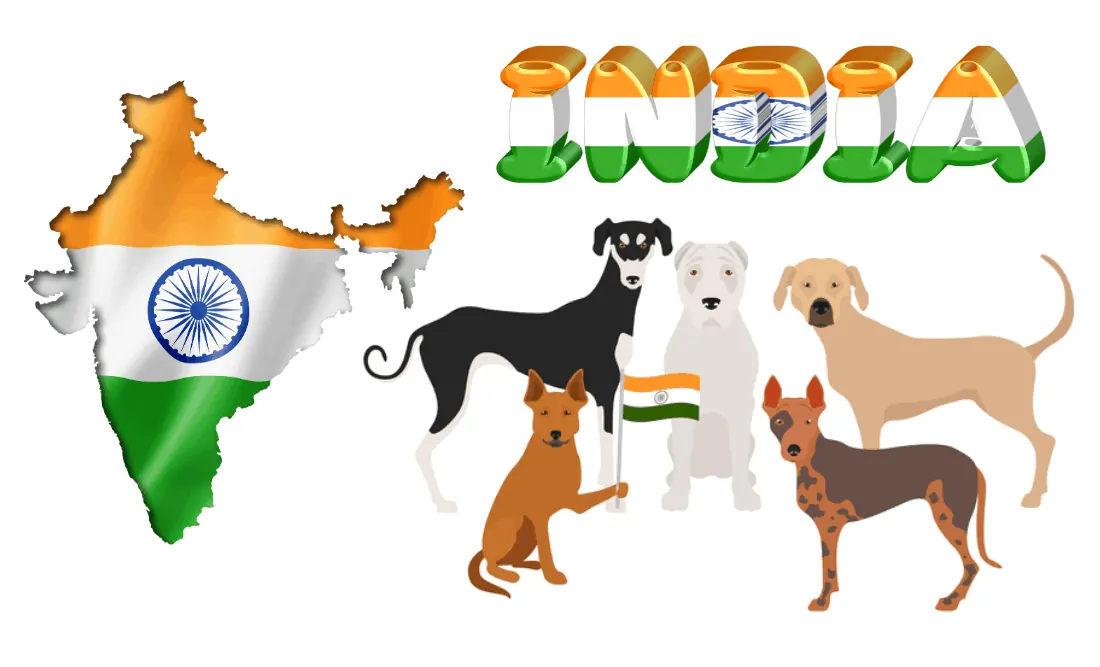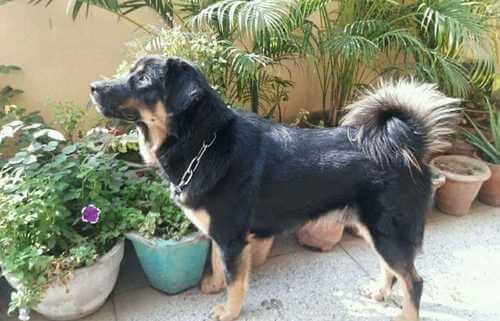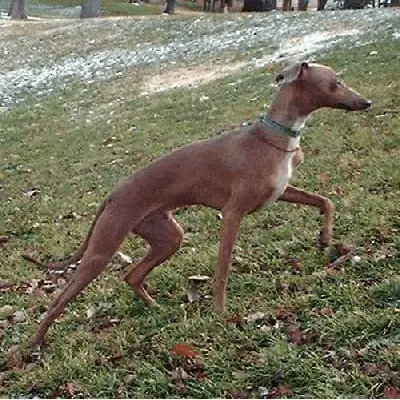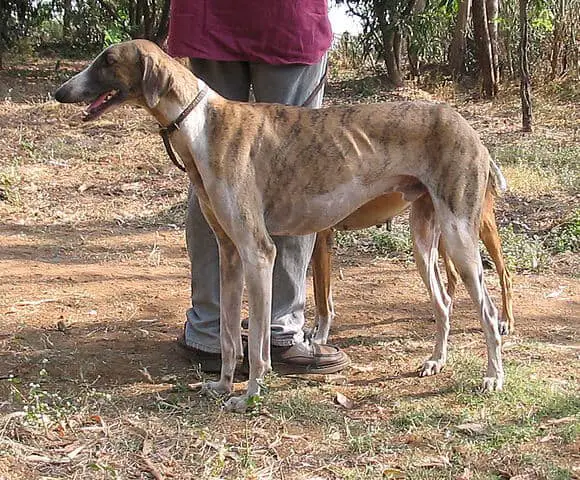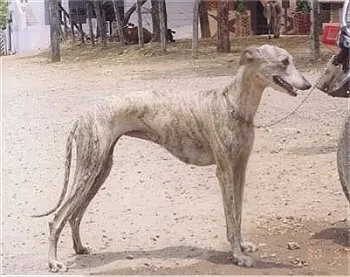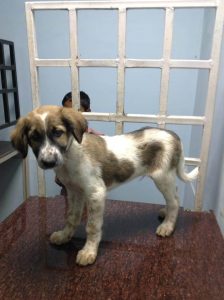In places like the US and Canada, it’s extremely rare to see stray dogs running around on the streets.
While there are many dogs that are sadly without homes, it’s not an epidemic.
Rather, dogs are loved, cherished, owned as pets, and regarded as part of the family.
But in some other areas of the world, like India, dogs are not so highly regarded.
Nothing in this world breaks my heart more than seeing man’s best friend struggling to survive on the side of the road, so today I hope to shed some light on the amazing Indian dog breeds, and hope to inspire some of you to think about adoption.
Before I jump into speaking about individual breeds, let’s talk quickly about the lives of dogs in India.
To put things into perspective for you, The Washington Post reported that India has the largest number of stray dogs in the entire world, with estimates reaching over 30 million stray dogs.
As the stray dog population continues to grow, so do the problems associated with it – dog bites, disease, and rabies are all common concerns in India.
In fact, BBC News said that over 20,000 people die from rabies each year in the country.
Because of this, humans in India have become to see dogs as “evil” or “vermin”, when in reality all they are doing is looking for food, water, and love.
Unfortunately, because there is no form of animal birth control in India, the stray dog population simply continues to increase.
So what can we do to help? I’d like to start by educating you about the different breeds of Indian dogs.
A lot of sites will introduce you to the top 5 Indian dog breeds, but I want to shine a light on all of them.
In return, I will be discussing the top 19 Indian dog breeds.
For each breed I will cover 6 key components: general description, personality and temperament, grooming, common diseases and conditions, history, and facts/latest news.
So without further ado, let’s introduce you to the list of Indian dog breeds with photos.
1) Bakharwal Dog
Description:
The Bakharwal is a solidly built, large, Indian breed of dog that is heavily boned, deep-chested, and carries a lot of muscle.
The breed stands between 24-30 inches tall and can weigh up to 130 pounds when fully grown.
The Bakharwal has a large head and a thick muscular neck, along with a short muzzle and floppy ears. They have long, extremely strong and powerful legs.
The Bakharwal dog has a thick coat of hair that can come in a variety of colors including black, tan, beige, or white. It’s also not uncommon for the breed to be piebald, or to have large areas of their coat that are spotted white, and large areas of their coat that are spotted are another color.
Personality and Temperament:
For hundreds of years, the Bakharwal has been bred exclusively for guarding livestock. This is a job that they take very seriously, and that has learned them to be courageous guardians.
Because of their history of fending off large threats like bears, lions, and wolves, the Bakharwal is extremely brave, and independent, and is rarely threatened or intimidated by competitors.
The breed is tolerant of people and loving towards their family, but can be aggressive and territorial toward other animals.
They do best when they are the only pet in the home, and should not be trusted around other dogs or smaller pets like cats or guinea pigs.
In terms of children, the Bakharwal is very affectionate towards them, but are sometimes a little too playful and don’t know the power of their own size. They should always be monitored when young children are around to prevent playful accidents.
Because Bakharwal is so independent, training can be difficult. The Bakharwal is an extremely intelligent breed that tends to become easily bored with routine commands. They require a strong and confident leader for proper training.
Because Bakharwal has a strong pastoral instinct, they should not be raised in apartments. This breed needs space to wander and run.
History:
The Bakharwal is an ancient breed of dog that originated in the Himalayan mountains and is considered indigenous to the higher altitudes of the Kashmir state of India.
The complete history of the Bakharwal is unknown, but many people believe that they originated over 300 years ago, and were developed by the Guijar people to protect livestock like sheep and cows.
The Bakharwal is believed to be related to the Tibetan Mastiff, as well as some older Molosser breeds including the Saih Sag, the Tuvan Sheepdog, and the Hyrcanian Mastiff.
The breed is still native to the mountains of India and is rarely seen outside of the country. It is not recognized by the AKC or any other official breed registry in the United States.
Even in India, the breed is rare. During the 1857 uprising, many Bakharwal dogs perished while working on the front lines.
While there were still some Bakharwals left, the breed is difficult to repopulate because they produce smaller litters than most other breeds. The Bakharwal female can only produce between 1-3 puppies per year and remains a rare breed in India.
Did You Know?
- There is little to no demand for the Bakharwal outside of the mountains of India.
- The Bakharwal is extremely independent and is considered to live a nomadic lifestyle.
- The Bakharwal is the rarest of all herding dogs.
- The future of the Bakharwal is at risk, and they are on the verge of extinction
2) Bully Kutta
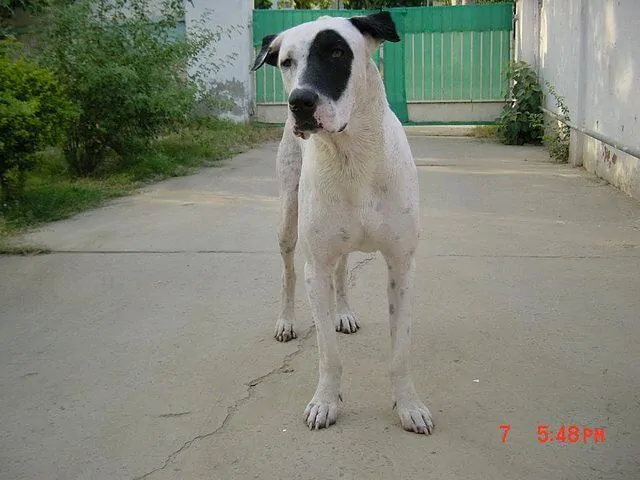
Stephany Ruso [CC BY-SA 3.0], via Wikimedia Commons
Description:
The Bully Kutta also referred to as the Bully dog, or the Alangu Mastiff is a large breed of dog that is extremely muscular and thick-boned. They range anywhere between 28-33 inches in height and weigh anywhere between 70-90 kg.
The Bully Kutta has a thick and broad skull and muzzle that is well proportioned to the rest of its body. They have small ears that are set far apart and stand erect. The tail is long and gradually tapers to a point.
Bully Kutta literally translates to heavily wrinkled dog. The word Bully comes from the root word of the Hindi-Urdu and Punjabi languages. Bohli which means heavily wrinkled and Kutta means dog.
Their skin around the neck and under the chin resembles that of a Korean Mastiff.
It has a short, but a double coat of fur that is thick, coarse, and straight. Their coat can vary in color and may be brown, fawn, white, brindle, or any range of other colors.
The Bully Kutta was bred for fighting purposes, and its strong, athletic, and muscular body is show of how powerful the dog really is.
Personality and Temperament:
The Bully Kutta has a long history of being used as a war and fighting dog, which has led them to develop dominant and aggressive personality traits.
The breed is described as highly territorial but makes an excellent guard dog.
With early socialization, the breed will become very loyal to their master and will aggressively defend them and their homes. With that being said, they need to be in secured fencing when the owner is not around, as they will attack strangers who enter the territory.
The Bully Kutta also does not play well with other animals. Their natural instincts are to attack, so they do best when they are the lone pet in a home. They also should not be around small children.
The Bully Kutta is not recommended for first-time dog owners, and should only be owned by experienced handlers that can display Alpha personality traits.
History:
The Bully Kutta is a rare breed of dog and is most commonly found in the Thanjavur and Trichy districts of Southern India.
They are considered to be an ancient breed, but like many breeds in India, the exact history of the dog has been lost in time.
Some people believe that the Bully kutta was created through the crossing of Pointers with English Mastiffs, others believe that this cannot possibly be true because they believe the breed dates back to a time before Christ.
Others believe the Bully kutta was created by the Persian Army and used to guard soldiers’ campsites.
Regardless of how the Bully Kutta originated, they were later adopted by the Indian Royal family and used to hunt large game. Eventually, the Royal family came to use Cheetahs for hunting, and the Bully was demoted.
Due to the ferocious and aggressive nature of the dog, they then became used for the purpose of dog fighting. Today dog fighting is illegal, and the Bully is primarily used for guarding homes.
Did You Know?
- Sadly, the Bully Kutta is still bred for dogfighting in Pakistan
- The name Bully is derived from the Hindi word “Bohli” which means “heavily wrinkled.”
- The Bully Kutta is one of the largest and strongest Mastiffs in all of North India
3) Chippiparai
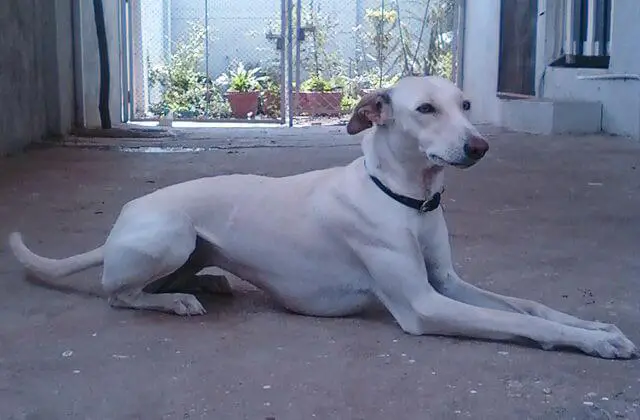
Richie2089 [CC0], via Wikimedia Commons
Description:
The Chippiparai Indian dog breed is not registered or bred to any specific appearance standards. In return, it can exhibit a great variation in size and appearance.
It is a medium-sized breed that stands between 20-25 inches tall and weighs between 30-65 pounds.
The Indian dog Chippipariai is a very thin dog, to the point where the ribs are usually visible.
The breed has a very short and smooth coat that is suited for the intense heat of Indian weather.
The coat can vary in color; the most popular colors are fawn, grey, black, brown, and reddish-brown. Some dogs may also have more than one color in their coat.
Personality and Temperament:
The Chippiparai breed is said to be a calm and peaceful breed that forms strong bonds with family members.
The breed is devoted and loyal to those that it is close to but is very reserved to who it gives its loyalty. The Chippiparai is suspicious of strangers and usually reacts to them nervously, but not aggressively.
While the Chippiparai is very gentle with people, the same is true with other animals. For centuries the breed was bred as a hunting dog and therefore has strong aggressive tendencies towards non-canines.
The breed may become aggressive to unfamiliar dogs, but when properly socialized, they should react just fine. That said, smaller dogs may be mistaken for prey and need to be introduced cautiously.
The Chippiparai is intelligent but stubborn and requires a strong owner for training.
They were bred for intense physical activity, and therefore require a substantial amount of exercise throughout the day. Dogs without proper energy outlets can become hyperactive and destructive.
History:
The Chippiparai originated in Tamil Nadu, India, where it got its name from the “Chippiparai” region.
They were bred by the Royal families of the area and were seen as an embodiment of royalty and dignity.
Aside from royalty, the breed was also very popular among the affluent class. It is believed that the Chippiparai is genetically linked to the royal dogs of Egypt, including the Sloughi and the Saluki.
They were brought via sea to India, where they mated with local breeds to create the Chippiparai we know today.
Aside from being beloved by the royal families, the Chippiparai has long been known as a fierce hunter. They were often used to kill various large and small prey, including deer, wild boar, pheasants, and hare.
Unfortunately, as the Dravidian royalties began to decline, so did the Chippiparai breed. They also started to lose popularity due to their genetic connection to Egyptian breeds, which were often looked down upon by the Hindus of the region.
Today, there is only a small population of Chippiparai in existence. Most of these are limited to the state of Tamil Nadu in India and are rarely seen outside of the country. Any American Kennel Clubs not currently recognize them.
Did You Know?
- Chippiparais are types of sighthound, and their eyes are positioned to give them a 270-degree view of the world around them.
- Most Chippiparais are so skinny that people think they are starving. This is not the case. Though they are not fat, most of their weight comes from muscles and bones.
- Sadly, the Chippiparais are currently at risk of extinction
4) Combai Dog

Richie2089 [CC BY-SA 3.0], via Wikimedia Commons
Description:
The Combai is a large dog that stands between 17-25 inches tall and weighs between 14-24 kg.
There is no unifying standard for the Combai. In return, there are many different crossbreeds.
As a result, it isn’t easy to give a definitive definition of the breed’s appearance since it is so variable. Even Combai’s that are closely related can be very different in appearance.
Most Combai’s have wide heads and powerful jaws and are described as lean cut with solid muscle.
The ears of the Combai are inconsistent – some drop down, some prick up, and some are folded backward. Tails are also inconsistent, ranging from short to long, straight or curled.
Most Combai’s have a distinctive feature: a ridge of fur running up their spine, which runs opposite in direction to the rest of their fur. Their coat is short and glossy and is usually red in color.
Personality And Temperament:
The Combai is known for its bravery and is considered an excellent guard dog. They are very loyal to their family and will fight to the death to protect them.
While they are considered ferocious dogs, when trained properly, they can easily refrain from aggression unless their family is in danger.
Much of a Combai’s personality depends on the owner and how they are raised. When socialized at a young age, Combai’s can be gentle with children and strangers, but without proper training, they can become aggressive.
The Combai will usually tolerate other dogs, but should not be around smaller pets due to their high prey instinct.
Combai’s can do well in a house or an apartment but do require a lot of exercises to help exhaust the large amounts of energy that they have.
History:
The Combai’s history can be traced back to the 15th century, where it originated in the Southern part of India.
With that being said, some enthusiasts would argue that the existence of the Combai dates back to the 9th century.
Anciently, the breed was used for hunting and was used to track and attack bison, deer, and wild boar.
Many also believe that the breed was used by armies in the revolt against British subjugation.
Unfortunately, despite efforts to maintain the breed, the numbers are dwindling and, like many other dogs on this list, is facing extinction.
Did You Know?
- The Combai is a type of sighthound, but unlike many other sighthounds, it does not have a 270-degree range of vision. Rather, they only have a 200-degree view.
- The Combai has adapted to the rough conditions in which it has previously lived and can survive on very little food.
5) Gaddi Kutta
Description:
The Gaddi Kutta is a large dog that stands around 34 inches tall and weighs up to 182 pounds.
They are a massive Mastiff-type breed but are considered to be more elegant and composed than their cousin, the Tibetan Mastiff.
The Gaddi Kutta has a thick, pointed skull and a thick neck that makes it difficult for predators to grab hold of.
They have a thick mane and a double coat with dark or black overcoating, combined with tan or brown patches on the face and underside.
Personality And Temperament:
The Gaddi Kutta is an extremely strong and intelligent breed of dog. They make great guard dogs and are often used for herding sheep and protecting land.
Their history of working in the Himalayas allowed them to build their tolerance for treacherous conditions.
They are extremely graceful, vivacious, and energetic. They require a great deal of exercise.
The Gaddi Kutta is extremely loyal and will protect their family at any cost. While they will work to fend off intruders, they are very loving and affectionate towards family members. They are good with children and will become very protective over them.
When properly socialized, they are unlikely to attack humans or other dogs unless provoked or threatened.
History:
Though it is known that the Gaddi Kutta is a type of Mastiff, the breed’s exact origins are unknown.
Many believe that they were developed through crossbreeding the Tibetan Mastiffs and wild dogs.
Though biology suggests otherwise, many locals believe the Gaddi Kutta is a cross between a tiger and a dog.
This local legend, however, may have come about because the breed is as ferocious as a tiger yet as loyal as a dog.
Over time, the breed has adapted to living outdoors and in the harsh conditions surrounding it.
Did You Know?
- The Gaddi Kutta got it’s name from the local term “Gaddi” which translates to Shepherd.
- The Gaddi Kutta shares genetics with the Australian dingoes
- The Gaddi Kutta is not considered the ideal breed for city life, which could limit their numbers in the future.
6) Gull Dong
Description:
The Gull Dong is a large breed of muscular and powerful dog.
They are taller than most Pakistani dog breeds and stand between 30-42 inches tall. They weigh between 90-140 pounds and have massive heads with powerful muzzles.
They have a short, smooth coat of hair that comes in various colors, including black, white, grey, and brindle.
The Gull Dong has small ears that can be floppy but are often cropped and erect.
Personality and Temperament:
The Gull Dong is a breed that is not well suited to be a family pet. While they are loyal and devoted to their master, they much prefer working on a farm to cuddling on the couch.
They tend to be very dominant, and require a strong owner who can take on the role of pack leader.
The Gull Dong has a natural distrust towards strangers and needs to be socialized and trained at a very young age.
Without the leadership of a strong owner, they can become difficult to manage. With that being said, the Gull Dong is a very intelligent breed with a strong leader who will learn very quickly.
This breed is bred to be a working dog and does not do well in apartments. Their ideal homestead is a farm or a house with a lot of lands.
If you can earn the loyalty and trust of the Gull Dog, they will be loving and affectionate and fight to protect you with their life.
History:
The Gull Dong originated in Pakistan, which was crossed between Gull Terriers and the Bully Katta.
Though the breed is popular in Pakistan and Northern India, it is rare anywhere else in the world.
Unfortunately, there are no official records that track the history of the breed. That said, it is well known that they were bred to be working dogs.
They have also been used as guard dogs, hunters, and fighting dogs. Sadly, though dog fighting is outlawed in most of the world, including Pakistan, it is often still practiced in the homeland.
Did You Know?
- The Gull Dong is a working dog and is happiest when given a job to do
- The Gull Dong costs between $39-$52 per month to feed and upkeep.
7) Gull Terrier

Robert Olivia [CC BY-SA 4.0], via Wikimedia Commons
Description:
The Gull Terrier is a mid-sized dog. They stand between 20-26 inches in height and weigh between 77-99 pounds.
The purest Gull Terriers have large, erect ears, but they may also have semi-erect or dropped ears depending on the purity.
The Gull Terrier is tall, broad-chested, and has a short, white coat. The coat is smooth, and though it is always white, some breeds might have dark facial markings. If the breed is any color other than white, it is not pure.
Personality and Temperament:
The Gull Terrier is very protective of both its property and its family and is often wary of strangers.
The breed is loyal and likes to be around its owner as much as possible.
The breed is good with children but should never be unmonitored around strangers.
They are very intelligent and easily trained if you start young. With that being said, the Gull Terrier is a feral dog that requires a strong leader that can provide firm and consistent training and discipline. Without structure, they may become destructive.
Gull Terriers should not be trusted around other dogs or pets. The breed is known to be quick, strong, and agile on its feet and will attack smaller animals without hesitation.
They are a very energetic breed and require regular daily exercise.
History:
The origins of the Pakistani Bull Terrier started when the British Army brought English Bull Terriers over to India.
These dogs were crossed with local breeds to create the Gull Terrier. This is why they so closely resemble their cousins, the English Bull Terrier.
Sadly, due to the fearless nature of the Gull Terrier, they were commonly used for things like bear baiting and dog fighting. These are now illegal in the country, and the breed is most commonly used as a guard dog.
Did You Know?
- Many people try to sell Gull Terriers that have been extremely inbred. It’s important to research a dog’s lineage before buying, as an inbred dog is likely to have far more health and temperament issues.
8) Indian Spitz
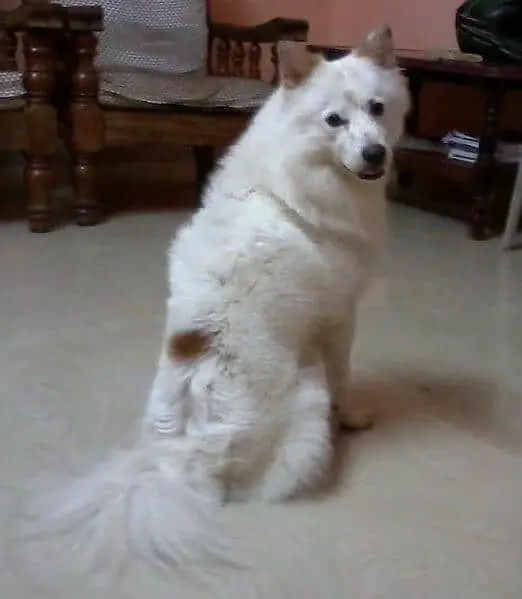
Ash7shobinth [CC BY-SA 4.0], via Wikimedia Commons
Description:
The Indian Spitz is a small to a mid-sized breed of dog that is often separated into two categories: the Smaller or Lesser Indian Spitz and the Greater Indian Spitz.
The Smaller Indian Spitz weighs between 11-15 pounds and stands between 20-25 cm tall. The Greater Indian Spitz is a little larger, weighing between 26-44 pounds and standing between 35-45 cm tall.
The breed has erect standing ears and a tail that curls onto the back.
They have long-haired coats that can become in several different colors, including brown and black, though they are most often a milky white. Though rare, some Indian Spitz can be a hybrid of black and white, much like a Dalmatian.
Personality and Temperament:
The Indian Spitz is a high-spirited dog that is loving and affectionate with its family, including children.
They are playful, intelligent, and very quick learners. They enjoy playing with children and usually get along well with other dogs.
The Indian Spitz, much like many other small breeds of dog, thinks it’s much larger than it is. They like to protect the household and will bark when strangers are nearby. Without proper training, barking can become excessive, so it’s important to start training at a young age.
Dogs without proper training can also develop other behavioral issues such as destructiveness, separation anxiety, nipping, and biting. They need a strong and consistent leader who can provide them with training and the large amounts of mental and physical stimulation that they require.
History:
The Indian Spitz is one of the most popular Indian dog breeds.
They were first introduced by the British and descended from the German Spitz.
Over time, they maintained their intelligence but adapted to the heat of the Indian summers.
Unfortunately, not much else is known about the history of the Spitz.
Did You Know?
- The Indian Spitz is often compared to the Samoyed, one of the most expensive dogs on the Indian dog breeds price list.
- The Spitz history links them with wolves. Like wolves, they like to hunt rodents and pigeons, and they often hunt in the same fashion as the wolf (knees bent and slowly approaching).
- The Spitz has an average lifespan longer than many other breeds (10-14). The oldest recorded Spitz lived to be 18 years old.
9) Jonangi
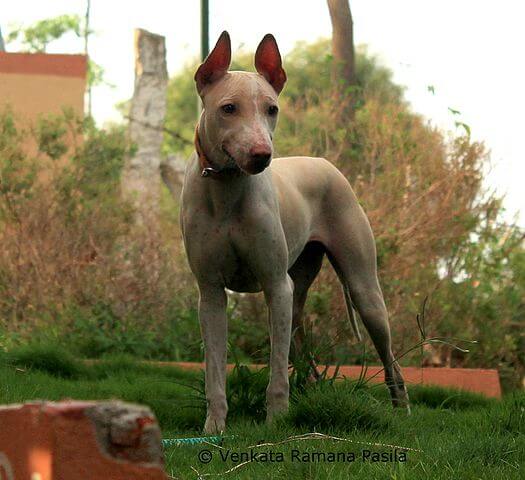
Vedichunt [CC BY-SA 4.0], via Wikimedia Commons
Description:
The Jonangi is a mid-sized dog that stands between 17-21 inches in height, and weighs between 28-48 pounds.
The breed is sleek, but muscular, with long and powerful legs. They have pricked ears and are best known for their unique wrinkled foreheads.
Because the Jonangi has been so interbred with other dogs, there is a lot of variation in their appearance.
Their coat is very short, but they come in various colors, including fawn, white, chocolate, black, and anything in between. They are often piebald or patchy, but their appearance can vary greatly.
Personality and Temperament:
The Jonangi is not the most intelligent breed of dog, but they will do anything for a treat and therefore are easy to train.
They are also very easygoing, and make excellent family dogs. The Jonangi breed is loving and affectionate with both adults and children.
They are protective of their family and can be wary of strangers but are unlikely to show aggression unless they feel threatened.
The Jonangi is best suited for an active family or owner as they have a lot of energy to expel.
History:
The Jonangi has a long history as a herding and hunting dog on the East Coast of India.
The breed is thought to have originated in the Kolleru and Pulicat Lakes regions, where duck herders bred them to keep them safe from predators.
Today the Jonangi is not recognized by any major kennel association, and though they were once a very popular breed, they are now nearing extinction.
Did You Know?
- In history, the Jonangi Dog often had to fend for itself. As a result, it developed long strides that allow it travel very long distances.
- The Jonangi dog doesn’t bark – it “yodels”
- It is very to difficult to find a Jonangi to buy. A puppy can cost anywhere between $3000-$6000.
10) Kaikadi Dog
Description:
The Kaikadi is a small breed of dog that stands between 35-45 cm tall and weighs between 37-47 pounds.
They have long, thin legs but very powerful thighs. They have a long, tapering tails and floppy ears that stand erect when alert.
The Kaikadi breed has short hair that can be white, tan, or black.
They are lean and muscular and are often said to resemble an Italian Greyhound or Whippet.
Personality and Temperament:
The Kaikadi is a breed of dog that loves the outdoors. They do best on farms or in homes with large open yards. They have a lot of energy and do not thrive in cities or apartments.
The breed is described as friendly, affectionate, and a good companion. They like to be around people but are also very independent and don’t mind being alone while their owner steps out.
The Kaikadi breed is very alert, territorial, and protective of their property. In return, they make excellent guard dogs.
The breed does well with children but can be very sensitive. If rowdy, undisciplined children are around; this breed will quickly become very anxious.
When socialized from a young age, the Kaikadi can do well with other dogs, but due to its strong impulse to chase and catch, it should not be left alone around smaller pets.
History:
The Kaikadi is a terrier-type dog that originated in India and were named after the Maharashtra Nomadic Tribe.
Unfortunately, the breed’s history is difficult to trace because the breed has been mixed with the stray dogs of India for many generations.
With that being said, it is well known that the Kaikadi tribes once used them for hunting small prey like vermin and hares.
Because the breed is so mixed, it is not currently recognized as a standard breed by any kennel clubs.
Did You Know?
▪ The Kaikadi dog is extremely rare, even in India. They are very difficult to find.
11) Kanni Dog
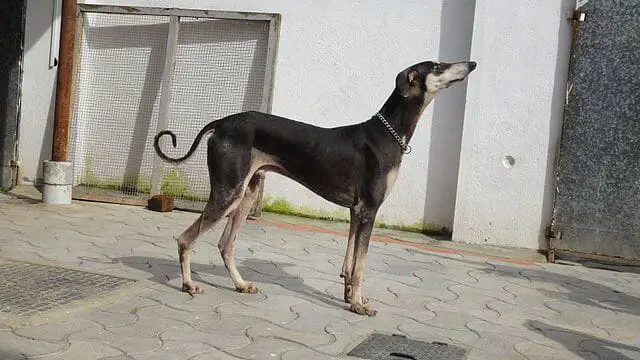
Futuristicpal [CC0], via Wikimedia Commons
Description:
The Kanni dog is a mid-sized breed that stands between 22-25 inches tall and weighs between 35-48 pounds. The breed is tall
and slender and bears a striking resemblance to the Greyhound.
They have skinny tail that drops down and may or may not curl at the end. Their ears vary depending on the variety, and may drop, semi-drop, or stand erect.
The breed has a short coat of fur that comes in four colors: brown, cream, black & tan, or brindle.
Personality and Temperament:
The Kanni is often described as a very shy breed of dog. That said, they are very loyal to and protective of their families.
They are very intelligent and easy to train, but they also have a will.
The breed has a great deal of energy and requires at least an hour of exercise daily. While they are not a destructive breed, they can become destructive if their energy is not exhausted in other ways.
The Kanni love human companionship and do not do well in isolation.
Grooming:
The Kanni breed has a very short, close-lying coat that does not require a lot of grooming. Professional grooming is never required, but a bath may be in order if they play in the dirt.
The Kanni are not heavy shedders.
History:
The Kanni Dog is native to the state of Tamil Nadu in India. In ancient times they were used by landlords for hunting. The name of the Kanni translates to “pure” and indicates their loyalty and purity of heart.
Unfortunately, not much else is known about the history of this breed.
Did You Know?
- The Kanni dog was traditionally given to newlywed brides as a gift of protection.
- The Kanni breed is extremely rare, and as of today, there are no current efforts to revive the breed.
12) Kumaon Mastiff
Description:
The Kumaon Mastiff is a large breed of dog that stands between 21-26 inches in height and weighs 150-180 pounds.
They have lean, muscular body, with large heads and thick necks.
The Kumaon Mastiff has ears that hang down and a long tapering tail.
The breed has loose skin and short fur that varies from light to dark in color, but that is almost always brindle.
Personality and Temperament:
The Kumaon is a very loving and loyal breed that makes excellent guard dogs. They have a strong protective instinct and may appear aggressive to intruders. That said, they are good with children and other pets.
The Kumaon breed requires a strong and confident owner and needs to be socialized from a young age.
They require regular stimulation, and if they don’t get enough, they can become destructive.
History
The Kumaon Mastiff is an ancient breed of dog indigenous to the region of Kumaon in the Himalayan Mountains. Like many breeds on this list, the exact history of the Kumaon is unknown.
Some dog researchers believe that it was foreign explorers that brought the dogs to the region and Indian Tribesmen that started to breed them.
Some researchers believe that the Kuamon are descendants of the Molosser breeds, while others say they are cousins of the Indian Mountain dog breeds.
Other researchers still suggest that Alexander the Great brought the breed to India in 300 BC.
Unfortunately, no documentation supports any of these claims as factual.
Did You Know?
- Kumaon Mastiffs are often mistaken for Great Danes due to their similar appearance.
- The Kumaon is now a rare breed, with only an estimated 150-200.
13) Mahratta Greyhound
Description:
The Mahratta Greyhound, sometimes referred to as the Maratha greyhound, is a large breed of dog that stands between 21-24 inches tall and weighs between 44-54 pounds.
They are a slim breed of sighthound yet very well-muscled and strong-backed.
They have a fur short coat that helps to protect them from the Indian heat and usually come in shades of black & tan, tan or brown.
Personality and Temperament:
The Mahratta has excellent eyesight, strength, muscle, and speed, making them excellent for the hunt. They have above-average intelligence but require repetitive training commands.
They are affectionate, loving, and friendly, but at the same time, they are independent and unlikely to create close bonds.
The Mahratta Greyhound enjoys social interaction and playing with children and other dogs. They also have a strong prey drive and should not be left unmonitored around smaller animals.
For the most part, however, the Mahratta Greyhound is a non-aggressive breed that makes a great family pet.
History:
The Mahratta is a rare dog breed, and little is known about its history. Many believe that the Mahratta Greyhound is of relation to the Saluki breed, while others theorize that they were derived from other indigenous sighthound breeds.
They have been used in history for hunting small and medium-sized game.
To date, they are not currently recognized by any major kennel club.
Did You Know?
- The average annual cost to own a Mahratta Greyhound is between $420-$780
14) Mudhol Hound
Description:
The Mudhol Hound, sometimes called the Caravan Hound, is a type of sighthound. It is considered a mid to large-size breed, standing between 22-28 inches tall and weighing between 45-85 pounds.
They are lean, muscular dogs with long legs and long necks.
They have v-shaped ears that hang down and a tail set high and curves at the end.
They have short fur that can be either smooth or silky and come in all color combinations, including red, fawn, grey, black, and sable.
Personality and Temperament:
The Mudhol Hound is a gentle breed loyal to its owners and families.
They are cautious towards strangers and don’t like being touched by anyone but their owners. For this reason, Mudhol needs to be socialized early.
They also require a gentle, but firm and consistent owner. The Mudhol is a sensitive breed, and when owners are too harsh, the dog can become nervous, leading to aggression.
Despite this, Mudhol usually do quite well with children and other dogs. That said, the Mudhol has strong hunting instincts and should not be trusted around smaller animals that could be considered prey.
Much of this dog’s personality depends on that of the owner. Consistent yet gentle owners will raise a Mudhol that is well adapted and gentle too. Harsh owners may create behavioral issues in the dog.
History:
Although the exact history of the Mudhol Hound is unknown, many people believe that they arrived in India by chasing the caravans of settlers arriving from Arabian and Asian countries (this is where they get their alternative name, the “Caravan” dog).
Though there is no documentation or proof, many people believe that the Mudhol is a direct descendant of the Afghan hound, which was bred with other local Indian breeds to create the Mudhol we know today.
Historically, this breed was very popular in India and was a common dog among Royalty and Peasantry.
They were most commonly used for guarding and hunting, but in the 1600s-1700s, they also served in the military to help fight for India’s freedom. Not only did they work as guard dogs at the time, but they were also used to sniff out bombs.
In more recent history, the breed has neared extinction, but many breeders are trying to reestablish and protect the Mudhol Hound.
Did You Know?
- The Mudhol is a type of sighthound that has a 270-degree field of vision.
- The Mudhol has little to no body fat, and is therefore very sensitive to rain and cold.
- In 2005, the Indian Postal Department issued stamps with the face of a Mudhol hound. They had a value of RS 5.
15) Indian Pariah Dog
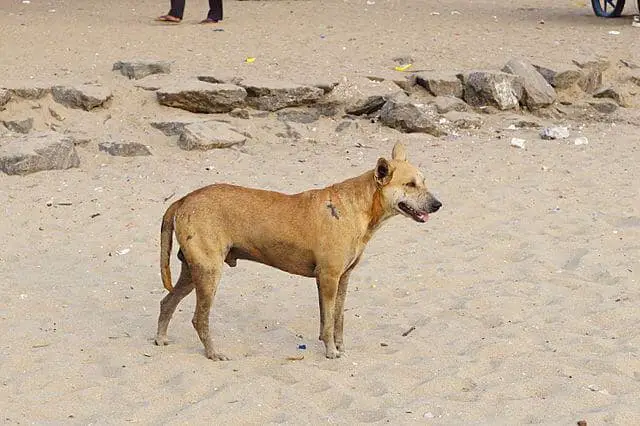
Vengolis [CC BY-SA 4.0], via Wikimedia Commons
Description:
The Indian Pariah is a mid-sized dog that stands approximately two feet tall and weighs between 14-32kg. Compared to many other breeds, the Indian Pariah has a lot of variability in size.
They have lean, muscular bodies, with ears that stand erect and a tail that hangs down and curls at the tip.
The breed has a double coat of fur with a short, coarse upper coat, and a softer undercoat. Their coat is short, and can vary in color from a light fawn to dark reddish-brown. Most dogs will also have white markings on the chest, limbs, and face. Other Indian Pariahs may be black or pied, but this is extremely rare.
Personality and Temperament:
The Indian Pariah is a happy breed of dog that loves to be social. They develop a strong bond with their owner, but are also friendly with strangers, children, and other dogs.
The Indian Pariah, however, can also be very territorial and will not hesitate to let you know when strangers are on the property. They can sometimes be described as a noisy breed and may have a tendency towards barking.
The breed is extremely intelligent and will quickly get bored of routine activities. They also have a lot of energy and require a diverse and stimulating environment to meet their needs.
History:
The term “Pariah” was originated from the word “Paraiyar” which was once used to describe the lowest class of people in the Indian system. The term Pariah then stemmed to describe feral dogs who lived along humans, but scavenged their way through life.
Unforunately, the exact origins of this dog are not recorded. With that being said, they share many physical features with fossil remains of dogs that have been found around the world in places in China and even Pompeii.
The dogs were not believed to have been bred for any particular purpose, but were rather a result of natural selection.
Today the breed is rarely seen outside of India, but is often seen in Indian homes as family pets.
Did You Know?
- The Pariah dog is a popular star in Bollywood movies and Television Soap Operas
- The Pariah dog came to be without any interbreeding or human interaction. Their characteristics were all derived through natural selection, making them one of the healthier breeds of dogs in India.
16) Rajapalayam Dog
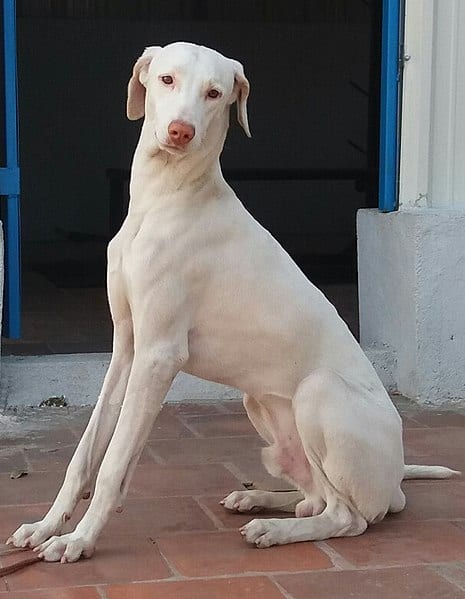
Vbala0733 [CC BY-SA 4.0], via Wikimedia Commons
Description:
The Rajapalayam is a large breed of sighthound that stands between 25-30 inches tall and weighs between 66-77 pounds.
One of the most distinguishable characteristics of the breed is their pink nose that stands out amongst their white coat.
The breed is slim and sleek with floppy ears and a slightly curved tail. They have a deep chest, long legs, and are designed to take down wild animals like boar.
The breed has a short, smooth coat that is almost always predominantly white.
They usually have dark brown eyes, but blue is also a possibility. Dogs of this breed born with blue eyes, however, are usually deaf or blind.
Personality and Temperament:
The Rajapalayam breed is a well-mannered dog that is known for its courageous attitude.
Originally used to hunt wild boar, these dogs are fearless hunters and great guard dogs. The Rajapalayam is not yappy, but will not hesitate to let you know when a stranger is around.
They tend to be naturally suspicious of strangers, as well as stand-offish towards other dogs. They also have a strong prey drive, and therefore should not be left alone around smaller animals or pets.
The Rajapalayam is loyal, playful, and affectionate companion to their owners, but do not make the best companions for small children as they do not like to be touched without consent.
Rajapalayam’s that are in households with children need to be socialized from a young age, and children need be taught how to respect the dog’s space.
The Rajapalayam is an intelligent breed of dog, but is also easily distracted. Training this breed requires a strong leader and a lot of patience.
History:
The Rajapalayam is an ancient breed of sighthound that is thought to have originated in the Tamil Nadu area of India.
Records of the Rajapalayam state that they were originally bred for Royalty to be used as hunting dogs, but later on they also became popular among regular civilians as well.
Because the dog was such a fierce hunter and courageous defender, they were also used as war dogs in several wars throughout the Eighteenth century.
Unfortunately, as the need for hunting declined, so did the need for the breed. By the 1980s the population dropped to below 200.
In the same year, the Kennel Club of India stepped in to launch campaigns to re-establish the breed. Sadly, the breed is still near extinction today.
Did You Know?
- Many people believe that the Rajapalayam breed may have contributed to the development of Dalmatians.
- The Rajapalayam is an extremely fast breed of dog with a gait much like that of a horse.
17) Rampur Greyhound
Description:
The Rampur Greyhound is a large breed of dog that stands between 24-30 inches in height, and weighs between 60-65 pounds.
They stand roughly the same height as an English Greyhound, but are wider and more solidly built.
The breed is thin, but muscular, and has long legs and a whip-like tail. The Rampur Greyhound have wide-set, floppy ears, and eyes that range from shades of yellow to shades of amber.
This breed also has distinctive webbed feet and flexible toes that allow them to engage in exceptional activities like balancing and climbing.
The Rampur Greyhound has a smooth, short coat that comes in a variety of different colors including grey, brindle, black, fawn, white, and white and black.
Personality and Temperament:
The Rampur Greyhound is a loving and affectionate breed, but tends to be more of a one-person dog than some other dog breeds.
The breed thrives on human companionship, and does well in families with children. With that being said, they do tend to be a rambunctious breed, and though they would not intentionally harm a child, they may accidentally knock them over.
Though the breed is very friendly, they can also be shy to warm up to strangers. They usually do well other Rampur Greyhounds, but might not do so well with other breeds of dog.
The Rampur Greyhound has a strong prey drive, and should not be trusted around smaller animals.
They also have extremely flexible toes, and are prone to jumping over fences. To prevent an escape, this breed should not be left alone in the yard.
The breed has a great deal of energy, and requires lots of exercise each day. They are intelligent, obedient, and easy to train, but can also be easily distracted.
History:
The Rampur Greyhound came about at the end of the 18th century when Ahmad Ali Khan, Nawab of Rampur, created a new breed of a hunting dog by combining two sighthounds together; the Tazi and the English Greyhound.
The Tazi were well known for their independence, aggression, and ability to take down wolves, while the English Greyhound was prized for speed and obedience.
When combined together, they created a dog that was fast, independent, obedient, and an excellent hunter – the Rampur Greyhound.
The Rampurs were often owned by the Maharajas (Indian Royalty) and used to hunt wild boar, but when the practice of hunting died down, so did the Rampur breed.
Sadly, the breed is on the edge of extinction and is not recognized by any major Kennel Club. While they have been noted in the United States, they are extremely rare anywhere outside of India.
Did You Know?
- While the main goal of the Rampur in history was to take down prey like wild boar, they were also often used to hunt more fierce predators like tigers and panthers.
- The Greyhound was featured on an Indian postage stamp in 2005 in nod to their National Importance
18) Vanjari Hound
Description:
The Vanjari Hound is a large breed of dog that stands between 26-29 inches tall and weighs between 52-70 pounds.
This is a type of Greyhound breed that early experts often compared with the Danish Boarhound and the Persian Greyhound.
They have a short, fine coat that was usually black, but could also come in shades of brown, merle, brindle, white, and cream.
Unfortunately, the exact description of the Vanjari Hound cannot be pinpointed, as they have mostly been interbred into different structures over the years.
Personality and Temperament:
The Vanjari Hound is said to be well-tempered and gentle.
The breed is extremely independent, and can often come off as unfriendly. They are often described as being anti-social, and are not well suited for homes with children or other pets.
The Vanjari Hound has no problem being on its own, and can often be extremely territorial of its property. Though they won’t usually bite unless they are provoked, they will let their owner know when there are strangers around.
Aside from that, they are a relatively quiet breed.
The Vanjari has above average intelligence, and can be easily trained. They can understand and memorize commands in as little as 15 tries, and often have down after just one or two repetitions.
History:
The Vanjari breed is indigenous to Northern India where they were kept by the Banjara people for hunting and guarding flocks and camps.
During the times when the Banjara were nomadic, the Vanjari dogs would follow them from place to place and were indispensable to the tribesmen.
But as times continue to progress, the breed has been introduced to uncontrollable amounts of interbreeding. As such, there are very few, if any, purebred Vanjari left today.
Did You Know?
- Vanjari dogs are near, or may already be, extinct. The only photographs of purebred Vanjari’s are very indistinct, hence why a detailed description cannot be given.
19) Vikhan Sheepdog
Description:
The Vikhan Sheepdog is a large breed of dog that stands around 25 inches tall.
With that being said, because there is no breed standard for the Vikhan Sheepdog, this statistic can vary. There is also a great deal of variation in weight.
The Vikhan is lean, but very muscular. They have a long, shaggy coat that can be black, fawn, or brown. A combination of these three colors is also possible.
Personality and Temperament:
The Vikhan Sheepdog is a very agile and fearless breed that is excellent for herding livestock.
They were bred to be working dogs, and therefore require a great deal of exercise each day. Without proper exercise and stimulation, the Vikhan can become bored and destructive.
The breed is extremely intelligent and can pick up complex commands very easily.
They are very protective and can become aggressive if prompted. If socialized at a young age, the Vikhan can be okay with other dogs, though they should be introduced in neutral territory.
They are not a good choice for families with children.
History:
The Vikhan is a breed that originated in Northwestern India, specifically in the Chitral region of Pakistan.
In history, it was used as a guardian of livestock, but was also used for hunting leopard. Currently, the breed is not recognized by any major kennel clubs.
Did You Know?
- Despite the name, the Vikhan sheepdog isn’t actually of any relation to the sheepdog we know today. Rather, it was simply given the name for the fact that it was used to guard livestock.
- In some parts of Pakistan the coat of the Vikhan is used as a substitute for wool and is woven into carpets and textiles.
Conclusion:
As you can see, many of the dogs on this list are on the verge of extinction. And though some dogs are still used for guarding homes and kept as pets, there are millions of others that are left to fend for themselves on the streets.
So the question then remains – what can you do to help?
Donate: If you want to help dogs in India, one of the easiest things that you can do is donate.
Many charities out there help to care for the stray dog population in India, but they all need funding to stay in operation.
Whether you donate to a cause that helps protect and heal dogs that have suffered abuse or neglect, donate to a cause that helps to prevent and control diseases, or donate to a cause that controls overpopulation, even $5 can make a difference – every penny counts.
Volunteer – Animal rights causes in India are always in need of volunteers. Whether you are a veterinarian who can help with services, or a regular individual who can help to brush, feed, and care for rescued dogs, everyone’s time is equally as valuable and helpful.
Adopt – If you want to do something great for a dog and yourself, you can also adopt. There is nothing more helpful that you can do for a dog that has suffered from neglect than to give them a home where they feel loved and cared for.
No matter how you contribute, you are making a difference. These dogs need you and we need them too.
Here are the rest of the dogs from Asia:


